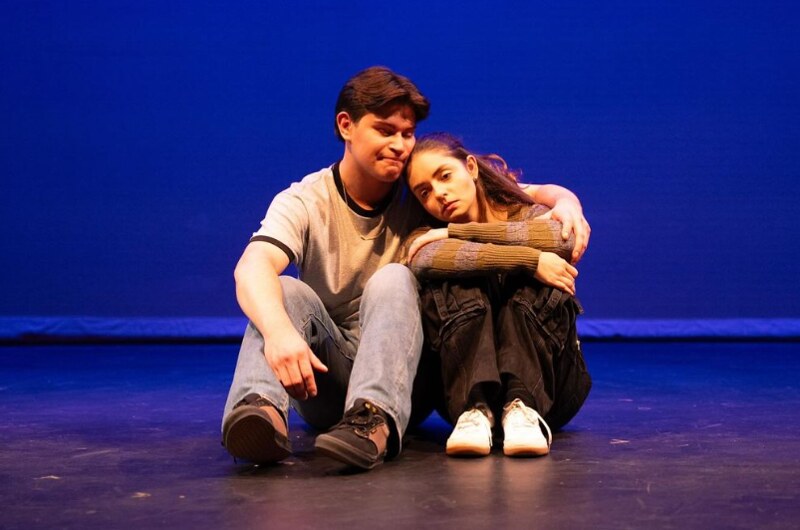Survival Is Complicated
Overstudy and Understudy Discuss Their Roles in SANCTUARY CITY


During each production at Next Act Theatre, more than one person prepares to take on a role. All shows have an overstudy—the actor who plays a role each night—and their understudy, who prepares to go on if the overstudy cannot. In SANCTUARY CITY, Ashley Oviedo plays G, while Patricia León de la Barra understudies the role. We sat down with both of them to talk about the play, the role and how their life experience informs their approach to this play.
What draws you to a play like SANCTUARY CITY?
Ashley Oviedo: What draws me to a play like SANCTUARY CITY is essentially the same thing that draws me to music and dance! I love telling stories, and from the time I was eight years old, it’s what I have always loved to do. I love knowing that I can create meaningful art through song or dance, but I especially love when a piece speaks to me personally. For me, it’s about the feeling I get as an artist when a song, dance, musical or play resonates with me as a person!
Are there things that you feel personally connect you to G? If so, what are they?
Patricia León de la Barra: As a Venezuelan international student, opportunities to inhabit a
character whose story echoes my own are rare. I first played her [as a student at Marquette University] during the closing months of the 2024 election. In many ways, G carried me through the immediate aftermath of Donald Trump’s second win, and she continues to accompany me now as I revisit her a year later.
Like G, I grew up in a violent and volatile home, and I know what it means to have to fight to survive and to love in the midst of instability. While I have always held privileges that G initially did not—being able to study here, for instance—the weight of her story still resonates within me. I resonate with her especially in this political moment, when immigration crackdowns are reshaping lives in America, just as I resonate with her through the memory of growing up in Venezuela under [Venezuelan Presidents] Chávez and Maduro, when protests, disappearances and economic crises were part of daily life.
I also find myself connecting deeply with the “uglier” sides of G: her lashing out, her distrust of others, her immense capacity to hurt the very people she loves. Those are impulses I recognize in myself, born of growing up in environments where safety could not be assumed and trust was dangerous. What I love about SANCTUARY CITY is that it does not condemn her for this. Instead, it frames her anger, her harshness and her contradictions in a sympathetic light. The play insists that survival is complicated, that love and harm can live side by side, and that those who endure instability should be seen not just for their wounds but for their humanity.
G’s story is not mine, but it lives very close to my marrow. That is why I carry her with me.

Does the way the first half of the play is presented change how you think about your role, memorize, rehearse?
AO: For plays that have this specific structure; time jumps, quick scene cuts,
et cetera, I usually like to focus on memorizing the throughline of the play itself! Of course, you always have to know the sequence of events in a play as an actor, but for this play specifically, I am focusing more than usual on remembering and figuring out exactly why the scenes are ordered the way they are, and that usually helps me remember! Rehearsal helps me a lot too! Once I get the show in my body, it’s honestly hard to forget… even after a few weeks of having closed a show!
What is the difference between preparing to perform the role and preparing to understudy it?
PL: Preparing to understudy the role is a different kind of discipline than preparing to perform it. As an understudy, I want to hold the character in my mind and body while also honoring Ashley’s process and choices. It requires flexibility and an attention to detail that is just as rigorous as performing, but in a quieter, more adaptive way. There is something both daunting and liberating about knowing I must be ready to step in at a moment’s notice, while also supporting the work happening onstage from the wings.
What do you think is the role of a play like SANCTUARY CITY in our modern society?
AO: To, on one hand, give a voice to every story that either never gets told, or is told in a one-sided way, and by doing that, inspire empathy and community not just in the groups of people that the play is written about, but everyone in between.
PL: To me, the role of SANCTUARY CITY is to remind us that immigration is never just an abstract policy debate. It is a lived experience. The text is an unsentimental yet deeply empathetic portrait of how real, complicated lives are shaped by laws that rarely leave space for nuance or humanity. Policy is blunt: it cannot hold the contradictions that make up a person’s life. This play does.
In an era where immigration discourse is weaponized for political gain, SANCTUARY CITY insists on the specificity of human experience. It asks audiences to sit with the ways in which status dictates the possibilities of love, trust and survival. And it does this without romanticizing its characters: B and G are allowed to be flawed. It shows us that immigrants do not need to be perfect, virtuous angels in order to be deserving of dignity and respect.
I think that’s the vital role of theatre in moments like these—to resist flattening, to complicate, and to demand empathy without sentimentality. SANCTUARY CITY argues for seeing the people whom immigration policies most affect. In a time of immigration crackdowns and increasingly rigid definitions of belonging, the play makes visible the cost of those abstractions on people’s real, tangible lives.
Despite being set in 2001, what makes this play still relevant in 2025?
PL: The play’s relevance is undeniable in 2025, as the president’s renewed immigration crackdowns deliberately target migrants—raiding, detaining, and even kidnapping people with no criminal record. SANCTUARY CITY shows how policies that seem abstract on paper devastate real lives, dictating who gets to feel safe, who gets to love freely, and who is forced into impossible choices. Though set in the early 2000s, its story mirrors today’s reality: a nation still denying immigrants’ belonging.

What excites you the most about SANCTUARY CITY? What scares or challenges you the most?
AO: What excites me the most about SANCTUARY CITY is the same thing as what scares me the most about it: as soon as I read the play, I had a very personal connection to it. Those are some of the most rewarding projects to work on as an artist, and I couldn’t wait to start in the months leading up to rehearsals. That same thing can also be a little scary, though. For every reason you can imagine, it’s a very vulnerable thing to put stories that feel so close to your own up [on stage] every night for friends, family and strangers to see.
What do you hope audience members take away from this play?
PL: I think SANCTUARY CITY exists to show a microcosm of what is, in many ways, the American story. It is about the compromises, sacrifices and acts of love that survival demands, and how those choices are shaped by forces far larger than the individuals who must endure them. For immigrant audiences, I hope there is recognition and admiration for the characters’ perseverance—for the way they continue to build lives and sustain hope even in systems designed to break them down.
For LGBTQ+ audiences, I hope the play’s exploration of chosen family, loyalty and the difficult negotiation of love feels both validating and expansive. I hope there is resonance in B’s relationship with Henry, which unravels under the weight of laws that deny their love legitimacy. They can’t marry; they can’t build a future together; and ultimately, they’re forced into a choice where love itself becomes a site of resentment. That struggle—of love colliding with systemic exclusion—is one that queer communities know intimately, and I think the play honors that history with empathy.
For all audiences, my hope is that they leave understanding that immigration and queerness are not abstract issues; they are lived in bodies, in relationships, in private moments of trust and betrayal.
Patricia, what does it mean to be studying and performing in the United States right now?
PL: I am afraid. For the first time since I moved to the States, I have not been able to go home and visit my family. This is the longest stretch of time I have ever gone without seeing my own mother. But I carry with me the immense sacrifices my parents have made to support my education at Marquette, and to only talk about this fear would be a disservice to their investment.
Despite the current political climate, I have found an incredible support network here in Milwaukee. Studying and performing here right now means honoring those sacrifices by giving my full presence and dedication to the work, even while navigating fear and distance. I am grateful to my mentors, especially [Next Act Administrative and Artistic Manager] Caroline Norton, Marquette Theatre faculty, the directors who have trusted me with opportunities, and my friends—who are all American, all amazing people—who have helped me navigate the stressors of living abroad. Thanks to their support, I feel welcomed, seen and loved, and that sense of belonging has allowed me to continue to take risks as an artist, even in a time of uncertainty.
What do you think is the role of hope in the arts right now?
AO: The role that hope serves in art today is to create a sense of calm, love and understanding among people. Art serves as a mirror so much of the time; it shows us our flaws and the things we may be avoiding in our own hearts. Art gives us the opportunity to sit with those difficult things and hope to be better as individuals and a society. Hope is the “why?” in my opinion. Why we choose to tell difficult and sometimes uncomfortable stories as artists, and why we choose to sit and listen as audience members.
PL: To persevere.
Anything else you’d like audiences to know about this play?
PL: Once, I overheard someone immediately dismiss [this play], saying it sounded “too sad.” I think that reaction is telling, and exactly why we need plays like this. Audiences shouldn’t shy away from stories because they carry pain or tragedy; that pain is part of the truth. At the same time, SANCTUARY CITY is not only a story of hardship. It is also full of love, joy and survival. It shows the beauty and humor that exist even in the harshest circumstances, and the ways people fight to hold on to each other despite everything stacked against them.
I hope this play cracks people’s hearts open the way it did mine.
Tickets are now on sale for SANCTUARY CITY by Martyna Majok. Call (414) 278-0765 or buy online now!
